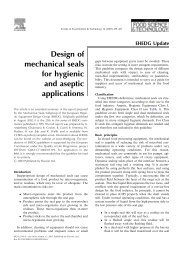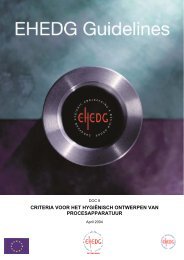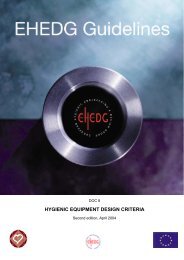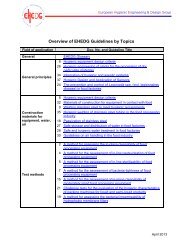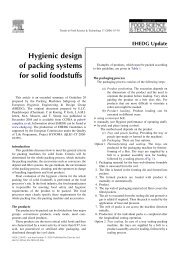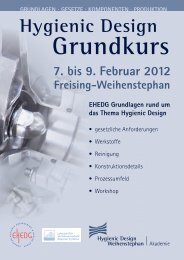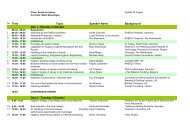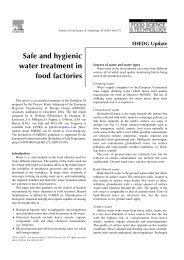Yearbook 2013/2014 - ehedg
Yearbook 2013/2014 - ehedg
Yearbook 2013/2014 - ehedg
You also want an ePaper? Increase the reach of your titles
YUMPU automatically turns print PDFs into web optimized ePapers that Google loves.
44 Hygienic design of floor drainage components<br />
That drains might contribute to segregation or zoning, and<br />
indeed their impact hygienically on the facility, is a matter<br />
for debate, though reference to drainage is made in a<br />
number of EHEDG derived publications (Lelieveld, Mostert,<br />
Holah: 2003; 2005; 2011). Zhoa et al. (2006) in their study<br />
of Listeria in poultry plants noted the importance of drains:<br />
“Floor drains in food processing facilities are a particularly<br />
important niche for the persistence of Listeria and can be a<br />
point of contamination in the processing plant environment<br />
and possibly in food products” (ibid, p. 3314).<br />
However, even when the provisions contained in component<br />
standards are adopted, these are not necessarily aligned<br />
with best hygienic practice. For example, the standard EN<br />
1253 permits the design of gullies with an effective sump, as<br />
illustrated in Figure 6. Here, the obvious sump provides all of<br />
the potential ingredients for bacterial growth.<br />
More recent work by Berrang et al. (2012) studied Listeria<br />
mobilization from the drain by inadvertent water spray during<br />
cleaning operations, with subsequent potential to transfer to<br />
food contact surfaces. Of note, Berrang cites studies where<br />
such bacteria have been detected in floor drainage even<br />
after extensive plant sanitation (ibid p. 1328).<br />
Reducing the potential for harbourage of such pathogens<br />
should be a key concern of any floor drainage product<br />
manufacturer concerned with hygienic principles.<br />
Floor drainage issues in practice<br />
Generally, two main issues give rise to hygienic concern:<br />
issues related to installation, and in particular the floor-todrain<br />
interface, and issues related to the component design<br />
itself. Here, the latter is considered.<br />
The choice of materials for drainage component manufacture<br />
is extensive and not necessarily constrained by the key<br />
European standard (EN 1253). Typically, where hygienic<br />
considerations apply, stainless steels are advocated. With<br />
the readily available supply of appropriate grade sheet,<br />
it should come as no surprise that many components are<br />
fabricated by none drainage-specific companies. Linear<br />
channels in basic form, especially, can be easily fabricated,<br />
as can simple ‘box’ type gullies. It is estimated that more<br />
than 200 suppliers fabricate drainage components in the<br />
European Union (EU) alone (ACO 2009), the vast majority<br />
of which are primarily fabrication companies with no specific<br />
expertise in drainage. Consequently, there is huge variation<br />
in how floor drains are fabricated, two examples are shown<br />
in Figure 5.<br />
Figure 6. Horizontal gully as portrayed in BS EN 1253.<br />
It thus becomes necessary to supplement general standards<br />
with further guidance. In the case of the floor gully, many<br />
of the design aspects of European Hygienic Engineering<br />
Design Group (EHEDG) guidance documents, particularly<br />
Document 13, may be economically incorporated in product<br />
design.<br />
ACO has sought to incorporate in its components:<br />
• Continuous welding of joints<br />
• Radiused corners<br />
• Drainability<br />
The new horizontal gully in Figure 7 shows a floor drain<br />
body that addresses the above points.<br />
Figure 5. A case for improved drainage component design.<br />
For the facility operator, specification of components that<br />
meet appropriate standards – Euronorms or their regional<br />
counterparts – ensures compliance with a number of criteria,<br />
not the least of which are load bearing and hydraulic capacity.<br />
As a matter of course, certification should be requested from<br />
component suppliers (e.g., for the internal floor gully the<br />
recommended reference is EN 1253 [2003]).<br />
Figure 7. Floor gully body addressing key principles of hygienic<br />
design.



